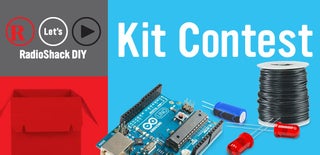Introduction: Light Up Drum Kit
As a drummer, I love drums. I love how they look; I love how they sound. As a electronics dork, I love building and designing circuits. It was only a mater of time before these two loves would come together. With this kit you will be able to install RGB lighting inside each of your drums that reacts to the vibrations when you hit your drum. Not only will you be able to adjust the sensitivity, but the duration that the lights are on as well.
Step 1: Parts Needed
Parts needed:
- Drum Set
- 12VDC Transformer (Plug Size M)
- Size M Panel-mount Coaxial DC Power Jack (Radio Shack SKU: 274-1563)
- Printed Circuit Board (Radio Shack SKU: 276-149)
- Project Enclosure (Radio Shack SKU: 270-1801)
- PC Board Terminals (Radio Shack SKU: 276-1388)
- LED Light Strip (I got mine here)
- 1uF Electrolytic Capacitor (x2)
- 555 Timer
- 2N2222 NPN Transistor
- TIP31 NPN Transistor
- 1N4007 Diode
- 100K Ohm Trimmer (x2)
- Piezo Element as the drum trigger (I got mine here because it had a self adhesive foam to attach to the drum head). If you would like it to look more professional you can actually use a real drum trigger as found here.
- 150 Ohm Resistor
- 470 Ohm Resistor
- 1K Ohm Resistor
- 10K Ohm Resistor
- Braket
- Wire
- Heat Shrink Tubing
- Solder
- Gorilla Glue
Tools Needed:
- Drill
- Drill Bits
- Dremel Tool
- Heat Gun
- Screwdrivers
Step 2: Project Enclosure & Circuit Board
We need to cut down the circuit board with our Dremel tool so that it will fit inside our project enclosure. Cut the corners off and size to the enclosure.
Step 3: Create the Circuit
I started out designing my circuit on a breadboard. If you feel confidant, you can go straight to soldering your parts together. You can find a video of the circuit on the breadboard here.
Step 4: Project Enclosure Modifications
Cut holes in the enclosure in order to access the things that are needed - like your sensitivity and duration pots. You will also need to cut three additional holes: a hole for the power coax connection, a hole so that you can change the color for your LED lighting and a hole so that you can connect your wires into the circuit.
Step 5: Install Lighting
Take the drum head off. Cut the LED strip to the needed length. Run the wires through the air vent. Attach to the inside of the drum using the self adhesive backing on the LED Strip. Replace drum head and tune.
Step 6: Drum Trigger (Piezo Element)
Now install the piezo element or, if you sprung for the drum trigger, install it in place here. I needed to lengthen my wires to reach my circuit. The piezo element that I used had a self adhesive pad on it to ease installation.
Step 7: Attach the Mount
Using Gorilla Glue (and tape till it dries), attach a mount. This is just a fencing mount that I found at my local hardware store. Make sure that the hole is larger than the diameter of your tension rod.
Step 8: Mount Your Circuit and Wire It Up
Now put it all together and have fun! Remember that you can change the sensitivity and duration using the pots and a small screwdriver. Whenever you are sick of the current color, you can easily change the color using the DIP switches in the circuit. Lastly, here is a video of the drum in action. I will post a video of my full kit when all my drums are finished.

Finalist in the
Musical Instruments Contest

Second Prize in the
Kit Contest

Participated in the
Weekend Projects Contest







![Tim's Mechanical Spider Leg [LU9685-20CU]](https://content.instructables.com/FFB/5R4I/LVKZ6G6R/FFB5R4ILVKZ6G6R.png?auto=webp&crop=1.2%3A1&frame=1&width=306)





